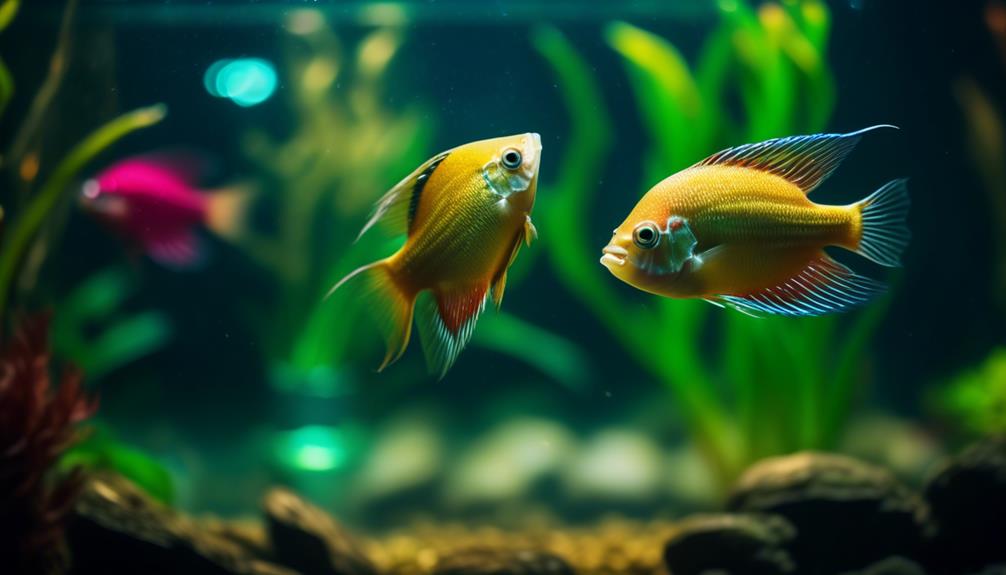Welcome to the captivating world of honey gouramis, where peace and vibrancy coexist in perfect harmony. These enigmatic creatures, native to the waters of India and Bangladesh, hold secrets waiting to be unveiled.
Imagine slow-moving ponds adorned with lush vegetation, providing the ideal backdrop for these hardy pets to thrive. But there is much more to discover beyond their tranquil beauty.
From the various types of honey gouramis to their unique care requirements and even the intricacies of their breeding process, this exploration is bound to leave you intrigued and yearning for more.
So, let us embark on a journey into the secrets of honey gouramis, where serenity and vibrancy converge, and the wonders of their world unfold before our eyes.
Key Takeaways
- Honey gouramis are a hardy and suitable pet for beginners due to their ability to adapt to seasonal fluctuations in water chemistry.
- There are different types of honey gouramis, including wild type, yellow gold, and red varieties.
- Honey gouramis are peaceful community fish that can be kept alone or in a group.
- They have a diverse diet and are not picky eaters, consuming both floating and sinking foods.
Habitat and Origins
The habitat and origins of Honey Gouramis, Trichogaster chuna species native to India and Bangladesh, are characterized by their preference for slow-moving ponds with abundant vegetation. In their natural environment, these gouramis thrive in water bodies that offer a calm and peaceful setting, allowing them to maneuver easily through the dense vegetation.
Their adaptability to home aquariums is a testament to their hardy nature. Honey Gouramis have the ability to withstand seasonal fluctuations in water chemistry, making them suitable for beginners in the fishkeeping hobby.
Their flat, oblong-shaped bodies and two modified ventral fins, which act like long, trailing whiskers, enhance their ability to navigate through the vegetation.
This unique combination of natural environment and adaptability makes Honey Gouramis an excellent choice for aquarium enthusiasts looking to create a serene and harmonious underwater ecosystem.
Different Varieties
Native to India and Bangladesh, Honey Gouramis exhibit a range of different varieties that add diversity and beauty to any aquarium setting. These varieties are distinguished by their unique colors and patterns, allowing enthusiasts to create visually stunning displays.
Here are three key factors for identifying honey gourami varieties:
- Honey Gourami Colors: The most common varieties include the wild type, yellow gold, and red. The wild type honey gourami displays a subtle combination of brown, black, and yellow hues. The yellow gold variety exhibits a vibrant golden coloration, while the red variety showcases a striking reddish hue.
- Identifying Honey Gourami Varieties: It is important to carefully observe the colors and patterns on the fish's body, paying attention to any distinct markings or variations. This can help in accurately identifying the different honey gourami varieties and ensuring that the correct species is purchased.
- Importance of buying the correct species: Each honey gourami variety has its own unique characteristics and requirements. Therefore, it is crucial to buy the correct species to ensure proper care and compatibility with other tank inhabitants.
Care and Behavior

Care and Behavior of Honey Gouramis can be better understood through observing their peaceful nature and compatibility with other similar-sized community fish. Honey gouramis are considered peaceful community fish and can be kept alone or in a group. They have a tendency to be shy if bullied by more aggressive fish. It is important to ensure that they are kept with compatible tank mates to avoid any conflicts.
They get along well with other fish of similar size and temperament. Social interaction is an important aspect of their behavior, and they thrive in a community setting. It is recommended to keep them with non-aggressive species such as tetras, rasboras, and dwarf gouramis.
Dietary Needs
To meet their dietary needs, honey gouramis require a diverse range of food sources that mimic their natural diet in the wild. These fish have specific feeding habits and nutritional requirements that must be met to ensure their health and well-being.
Here are three important aspects of their diet:
- Insect larvae and crustaceans: Honey gouramis primarily feed on small bug larvae and crustaceans in their natural habitat. These protein-rich food sources provide essential nutrients for their growth and development.
- Omnivorous diet: Honey gouramis are not picky eaters and consume both plant and animal matter. They willingly eat a variety of foods, including flakes, pellets, freeze-dried and frozen foods. Offering a mix of these options ensures that they receive a balanced diet.
- Floating and sinking foods: Honey gouramis are active swimmers and eat both floating and sinking foods. Providing a combination of floating and sinking pellets or flakes allows them to feed at different levels in the tank.
Breeding Honey Gouramis

Honey gouramis, with their specific dietary needs in mind, require specific conditions and behaviors for successful breeding. Breeding honey gouramis can be achieved by following certain techniques.
To initiate the breeding process, it is recommended to set up a separate breeding tank with suitable conditions. This includes maintaining a temperature range of 77-82°F (25-28°C) and providing ample hiding places such as plants or caves.
Once the tank is ready, a male and female pair should be introduced. The male honey gourami plays a significant role in the breeding process by constructing a bubble nest. He uses saliva to create bubbles and arranges them on the water surface. This bubble nest serves as a safe haven for the eggs and the fry.
The male then courts the female by displaying vibrant colors and performing intricate mating dances. After successful mating, the female lays her eggs, which are then fertilized by the male. The eggs hatch after 24-36 hours, and the fry become free-swimming after 1-2 days.
Proper care should be taken to ensure the survival of the fry by providing them with suitable food and maintaining optimal water conditions.
Frequently Asked Questions
What Is the Average Lifespan of a Honey Gourami?
The average lifespan of a honey gourami is approximately 3-5 years. To care for them properly, provide a suitable tank environment, a balanced diet, and maintain proper water conditions. Breeding honey gouramis involves creating a breeding tank with specific conditions and introducing a male and female pair.
Are Honey Gouramis Compatible With Other Types of Gouramis?
Honey gouramis are generally compatible with other types of gouramis in community tanks. They are peaceful fish that get along well with similar-sized species. However, it is important to consider the specific needs and temperament of each species before introducing them.
Can Honey Gouramis Be Kept in a Planted Aquarium?
Honey gouramis can be kept in a planted aquarium, providing aquascaping tips and reaping the benefits. The lush vegetation offers hiding places, reduces stress, and promotes natural behavior. Additionally, the plants contribute to water quality and aesthetic appeal.
Do Honey Gouramis Require a Specific Water Temperature for Optimal Health?
The optimal water temperature for honey gouramis is crucial for their overall health and breeding success. Fluctuations in temperature can impact their reproductive behavior and the survival of their fry. Maintaining a stable temperature is essential for their well-being.
How Often Should Honey Gouramis Be Fed and What Is the Recommended Feeding Schedule?
Honey gouramis should be fed small amounts multiple times a day to replicate their natural feeding behavior. A recommended feeding schedule would be 2-3 small feedings daily, ensuring they consume all the food within a few minutes.
Conclusion
In conclusion, the honey gourami, with its captivating appearance and adaptability, proves to be an excellent choice for beginners in the world of fishkeeping. Its vibrant colors, unique body shape, and compatibility with other community fish make it a peaceful and vibrant addition to any aquarium.
Despite the confusion surrounding different varieties, proper identification and care can ensure a rewarding experience with these mesmerizing creatures. By following the guidelines provided in this comprehensive guide, aquarists can unlock the secrets of honey gouramis and create a thriving aquatic environment.

